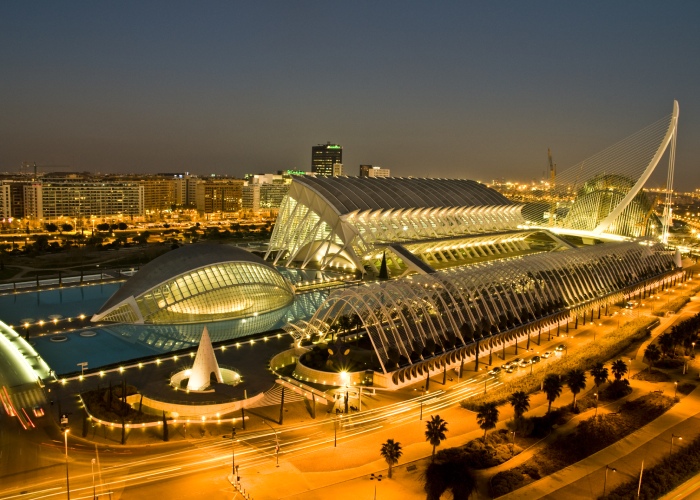The City of Arts and Sciences is today one of the most iconic places in Valencia. With its futuristic shapes, vast pristine buildings, and expansive, brilliantly blue pools, this complex attracts millions of visitors from around the world every year. A symbol of architectural boldness and cultural innovation, it has become a must-see for anyone discovering the city.
Yet few people realize that this spectacular space was once nothing more than an abandoned section of the Turia River, left empty after it was diverted following the catastrophic floods of 1957. Where only wastelands, industrial ruins, and derelict areas remained, the city recognized the potential for a project capable of radically transforming Valencia.
The history of the City of Arts and Sciences thus shows how Valencia managed to turn an urban problem into a true cultural, tourist, and identity-driving engine. This visionary project not only breathed new life into a forgotten space but also helped shape the modern and dynamic image of the city, now recognized as a model of urban reinvention.

Thus, the City of Arts and Sciences perfectly illustrates a city’s ability to reinvent itself and create a space that is both useful and aesthetically pleasing.
1. An old riverbed turned into an opportunity
In 1957, a devastating flood hit Valencia. To prevent this from happening again, the city decided to divert the Turia River. The former riverbed remained empty for years, becoming a long wasteland at the heart of the city.
During the 1980s and 1990s, the municipality realized this space represented a unique opportunity: to turn it into a vast park and host an ambitious cultural project. This is how the idea of creating a complex dedicated to science, art, and nature emerged — a place capable of energizing the city while giving it a new identity.
2. The futuristic vision of Santiago Calatrava
To design the project, the city called upon Valencian architect Santiago Calatrava, known for his sculptural-looking constructions. He imagined an architecture inspired by nature, movement, and Mediterranean light. His curved, elongated, and sometimes organic forms give the impression of belonging to a distant future.
He was joined by engineer-architect Félix Candela, a specialist in concrete shells and vaults, who contributed notably to the Oceanogràfic. Together, they defined the aesthetic signature of the complex: a white, luminous, almost unreal universe.
3. A project built step by step
The City of Arts and Sciences was not built all at once, but gradually. The first building to open was the Hemisfèric, in 1998. With its eye-shaped form set on the water, it immediately became a symbol of the project. Two years later, in 2000, the Príncipe Felipe Science Museum opened, followed by the Oceanogràfic in 2001, which became the largest aquarium in Europe.
In 2005, the Reina Sofía Opera House completed the ensemble, offering Valencia a modern and imposing opera house. Later, other elements such as the Umbracle, the Ágora, and the Assut d’Or Bridge were added, giving the site even more cohesion. Today, the complex stretches over more than two kilometers along the former Turia riverbed.
4. A profound transformation of Valencia
The City has deeply changed Valencia’s image. It has become one of the most visited places in Spain and has helped give the city a “new”, modern feel oriented toward culture and innovation. Local residents have also benefited from this transformation: the site and the Turia Gardens have become places for walking, leisure, and outdoor activities.
This dynamic has had a significant economic impact. The surrounding neighborhoods developed, businesses multiplied, and tourism experienced strong growth. The City helped create new attractiveness, both for visitors and residents.
Conclusion
The City of Arts and Sciences is a symbol of Valencia’s ability to reinvent itself. What used to be an abandoned riverbed has become one of Europe’s most renowned cultural and scientific complexes. Thanks to the architect’s vision and the city’s ambition, Valencia has created a unique place where architecture, science, nature, and art come together. Even today, the City continues to embody the future and a renewed vision of Valencia.
